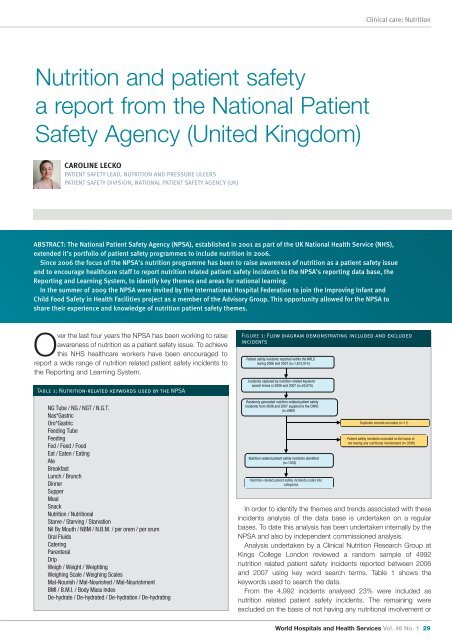vol46.1 LR.pdf - International Hospital Federation
vol46.1 LR.pdf - International Hospital Federation
vol46.1 LR.pdf - International Hospital Federation
You also want an ePaper? Increase the reach of your titles
YUMPU automatically turns print PDFs into web optimized ePapers that Google loves.
Clinical care: Nutrition<br />
Nutrition and patient safety<br />
a report from the National Patient<br />
Safety Agency (United Kingdom)<br />
CAROLINE LECKO<br />
PATIENT SAFETY LEAD, NUTRITION AND PRESSURE ULCERS<br />
PATIENT SAFETY DIVISION, NATIONAL PATIENT SAFETY AGENCY (UK)<br />
ABSTRACT: The National Patient Safety Agency (NPSA), established in 2001 as part of the UK National Health Service (NHS),<br />
extended it’s portfolio of patient safety programmes to include nutrition in 2006.<br />
Since 2006 the focus of the NPSA’s nutrition programme has been to raise awareness of nutrition as a patient safety issue<br />
and to encourage healthcare staff to report nutrition related patient safety incidents to the NPSA’s reporting data base, the<br />
Reporting and Learning System, to identify key themes and areas for national learning.<br />
In the summer of 2009 the NPSA were invited by the <strong>International</strong> <strong>Hospital</strong> <strong>Federation</strong> to join the Improving Infant and<br />
Child Food Safety in Health Facilities project as a member of the Advisory Group. This opportunity allowed for the NPSA to<br />
share their experience and knowledge of nutrition patient safety themes.<br />
Over the last four years the NPSA has been working to raise<br />
awareness of nutrition as a patient safety issue. To achieve<br />
this NHS healthcare workers have been encouraged to<br />
report a wide range of nutrition related patient safety incidents to<br />
the Reporting and Learning System.<br />
Table 1: Nutrition-related keywords used by the NPSA<br />
NG Tube / NG / NGT / N.G.T.<br />
Nas*Gastric<br />
Oro*Gastric<br />
Feeding Tube<br />
Feeding<br />
Fed / Feed / Food<br />
Eat / Eaten / Eating<br />
Ate<br />
Breakfast<br />
Lunch / Brunch<br />
Dinner<br />
Supper<br />
Meal<br />
Snack<br />
Nutrition / Nutritional<br />
Starve / Starving / Starvation<br />
Nil By Mouth / NBM / N.B.M. / per orem / per orum<br />
Oral Fluids<br />
Catering<br />
Parenteral<br />
Drip<br />
Weigh / Weight / Weighting<br />
Weighing Scale / Weighing Scales<br />
Mal-Nourish / Mal-Nourished / Mal-Nourishment<br />
BMI / B.M.I. / Body Mass Index<br />
De-hydrate / De-hydrated / De-hydration / De-hydrating<br />
Figure 1: Flow diagram demonstrating included and excluded<br />
incidents<br />
Patient safety incidents reported within the NRLS<br />
during 2006 and 2007 (n=1,612,014 )<br />
Incidents captured by nutrition-related keyword<br />
search terms in 2006 and 2007 (n=52,675)<br />
Randomly generated nutrition-related patient safety<br />
incidents from 2006 and 2007 supplied to the CNRG<br />
(n=4992)<br />
Nutrition-related patient safety incidents identified<br />
(n=1433)<br />
Nutrition-related patient safety incidents coded into<br />
categories<br />
Duplicate records excluded (n=11)<br />
Patient safety incidents excluded on the basis of<br />
not having any nutritional involvement (n=3548)<br />
In order to identify the themes and trends associated with these<br />
incidents analysis of the data base is undertaken on a regular<br />
bases. To date this analysis has been undertaken internally by the<br />
NPSA and also by independent commissioned analysis.<br />
Analysis undertaken by a Clinical Nutrition Research Group at<br />
Kings College London reviewed a random sample of 4992<br />
nutrition related patient safety incidents reported between 2006<br />
and 2007 using key word search terms. Table 1 shows the<br />
keywords used to search the data.<br />
From the 4,992 incidents analysed 23% were included as<br />
nutrition related patient safety incidents. The remaining were<br />
excluded on the basis of not having any nutritional involvement or<br />
World <strong>Hospital</strong>s and Health Services Vol. 46 No. 1 29

















